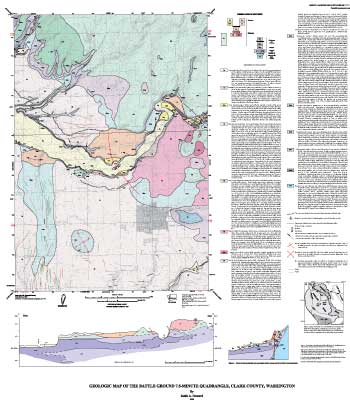
U.S. Geological Survey
Miscellaneous Field Studies Map MF-2395

|
INTRODUCTION The Battle Ground Quadrangle in the northeast part of the Portland basin exposes a series of Neogene to Quaternary nonmarine deposits that rest unconformably on a locally exposed basement of Paleogene lava flows. The earliest event recorded in the quadrangle was the accumulation of Paleogene lava flows in an ancestral Cascade volcanic arc. Following burial, zeolite-grade metamorphism, and partial exhumation of these volcanic rocks an ancestral Portland basin began to develop in middle Miocene time. The basin served as a depocenter in late Miocene, Pliocene, and possibly Pleistocene time for a series of fluvial and alluvial-fan deposits mapped as members of the Troutdale Formation. The Troutdale Formation was derived partly from distant eastern sources via a source stream that crossed the Cascade Range and flowed northwest, and partly from local west-flowing sources. West-flowing streams, possibly including Pleistocene glacial outwash, deposited the youngest member of the Troutdale Formation after dissection of the formation’s lower members. Parts of the Troutdale Formation were folded into a syncline and a dome. Pleistocene ice sheets from the northeast overrode and deposited drift on the hilly northeast part of the quadrangle to nearly as far south as where the town of Battle Ground now sits. Subsequent basalt eruptions built cinder cones and flows atop the drift near Battle Ground about 100,000 years ago. The post-glacial westward course of the East Fork Lewis River across the quadrangle cut a late Pleistocene valley north of the cones and flows. As the river incised it cut sloping ramps at meander bends and it isolated a former valley floor as terraces 30 to 40 m above the river’s modern flood plain. In latest Pleistocene time one or more giant floods that had burst down the Columbia River valley from glacial Lake Missoula flowed northwest across much of the quadrangle, depositing fine sand at elevations up to about 300 ft (90 m). The catastrophic flooding fluted and locally eroded into the Troutdale Formation, and deposited transverse fluvial dunes of fine sand as thick as 15 m atop a 30-m high terrace overlooking the East Fork Lewis River. |
An ASCII text version of the geologic description pamphlet for this report
 |
|
Files
Available for Download
|
||
|
File
Name
|
Description
|
File
Size
|
| bgmap.pdf | PDF file containing this geologic map | 11.9 MB |
| geoltext.pdf | PDF file of the geologic description pamphlet with figures and an appendix containing the readme file (digital database description) | 780 KB |
| 2395ps.tar.gz |
Compressed unix archive that contains a PostScript plottable file of the geologic map, base map, cross sections, correlation of map units, description of map units, and index map of the Battle Ground 7.5' quadrangle. Scale 1:24,000. Map sheet is 36 by 38 inches. The archive also contains the geologic descripion pamphlet as a PDF file |
13.4 MB |
| metadata.txt | FGDC-compliant metadata for this report | 24 KB |
| 2395db.tar.gz | Compressed unix archive containing the digital database for this publication | 32.2 MB |
Download a free copy of Adobe Acrobat Reader
| Help | PDF help | Geopubs main page | Western MF-maps |
| U.S. Geological Survey | Geologic Division | Earth Surface Processes |
For questions about the content of this report, contact Keith Howard
This report will also be available via print on demand from:
USGS Information
Services, Box 25286,
Federal Center, Denver, CO 80225
telephone: 303-202-4210; e-mail: infoservices@usgs.gov
| Department
of the Interior | Privacy Statement | Disclaimer
| Accessibility |
URL of this
page: https://pubs.usgs.gov/mf/2002/2395/
Maintained by: Michael Diggles
Last modified: June 16, 2005 (mfd)